How to Grow Strawberries & Get a Farmer's Sized Harvest
Author: Jen Worst | Editor: Omar Alonso
Review & Research: Jen Worst & Chris Miller

Learning how to grow strawberries is as easy as following these easy instructions. The real challenge is patience and self-discipline. Someone's got to plant and water them, after all.
These sweet summer delights are so many people's favorite refreshing fruit that it's no wonder there's such an uptick in interest in growing strawberries. In shakes, salads, jams, ice cream, or by themselves, I'm not aware of anyone that doesn't love this tasty snack.
Strawberries are very easy to grow, and if you follow this guide, you can have a harvest right from your own garden. Let's get those strawberries growing!
How to Plant Strawberries
As a quick bit of trivia, we have mentions of strawberries mentioned by the Roman poets Ovid and Virgil as far back as the first century AD, but they were ornamental then. We know wild strawberries were picked and eaten long before that. It was around the 1300's that strawberry cultivation began in Europe by the French.
Let's start from the beginning and go through the process. You need to know the when to plant strawberries, how to prepare your garden, how to actually plant them and care for them, and then of course we'll talk about when and how to harvest and store them so you can have long-term enjoyment from your hard but rewarding work.
Different Types of Strawberry Plants
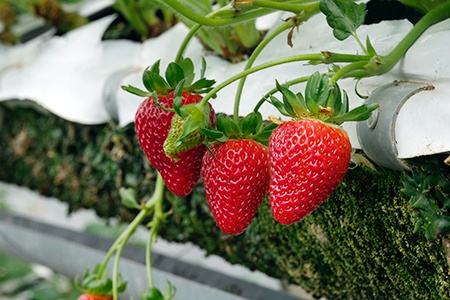
First you need to decide which type of strawberry you want to grow. Each has various benefits, depending on your goals.
- Ever-Bearing – these provide three havests. The first big crop comes during spring, then a second lighter harvest in the summer, and finally a third harvest in late summer or early fall.
- June-Bearing – these give one big harvest all at once during a three week period usually in June.
- Day-Neutral – these continue to bear fruit throughout the season as long as the temperature is between 35 and 85 degrees Fahrenheit, though the total harvest is less than that of the June-bearing variety. They'll produce until the first frost in late autumn or in winter.
So you have a choice to make. Do you want one bigger harvest, three sequential but increasingly smaller harvests, or continual access to strawberries but ultimately a lesser amount in total?
There are breeds that do better in different regions of the United States. Northeaster does well in the northeast. Primetime thrives in the mid-atlantic region. Cardinal grows well in the south, while Camarosa loves the west coast. Sable is great for zone 3 and Tristar is perfect for growing in containers like hanging baskets.
When to Plant Strawberries
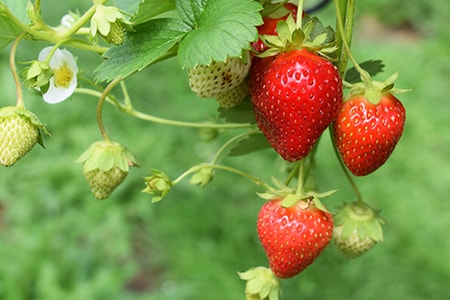
Depending on where you live, the right time to plant strawberries can vary due to the temperature differences. Some varieties of strawberries thrive better in certain regions, but the main concern is to plant them as early as you can once the soil is workable and not frozen.
Go to a trusted nursery and ask about the recommended variety for your region. Make sure that the plants are resistant to diseases too. The nursery likely will have handled these already since the know how to grow strawberries well and their success depends upon your own at home.
Strawberry plants can survive another year, but it's best to plant new ones each year. If you don't, your harvests will be smaller and the fruit quality will suffer to some degree. It's easy to plant them once you go through the process once, so don't worry about that.
How to Prepare the Garden Soil
Strawberry plants need well-drained soil to avoid problems such as root rot, so you can choose to grow them in raised beds or even raised rows in the garden. They're sun-loving plants; they need 6 to 10 hours of direct sun exposure to grow and thrive, so definitely plant them on a site where they have sufficient sunlight daily.
They aren't picky fruits; they'll adapt and tolerate almost all types of soil as long as it drains well and doesn't have standing water problems. With that said, the best kind of soil is loamy. That means it has a mixture of sand, silt, and less clay. It's all about water drainage.
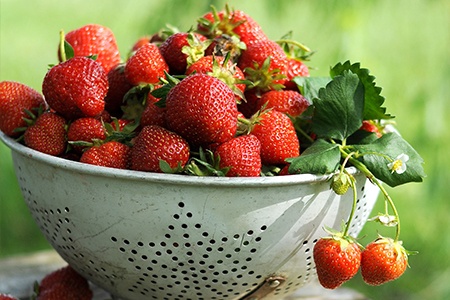
If you feel like your soil is too dry or sandy for strawberries, you can use an inch layer of compost, manure, or fertilizer. Don't worry about things like maggots in your compost. When it comes to knowing how to grow strawberries, you'll learn that the typical trash maggot poses no threat but helps make compost usable by the plant.
You just want plenty of nutrients without too much nitrogen, which will make the leaves grow big but diverts too much energy from the fruit. If you've fertilized before and know the nitrogen levels are good, you can find a zero nitrogen fertilizer like 0-20-20 to use.
It is best to start working the soil, loosening and tilling under compost or fertilizer, two months before planting strawberries. Raise a mixture of clay soil and 4 inches of compost on the site where you are deciding to plant your strawberry. The loamier the soil, the less compost you need to reach the right consistency.
Avoid growing your strawberries in alkaline soil. A pH of 5.5 to 7 is excellent. If you don't have that on the ground, you can grow the plant in half barrels or any other big container. Just make sure they have enough rich soil, compost, and manure mix in them.
Strawberry plants requires heavy feed, so make sure you aren't planting them on the same site as before without fertilizing first. If the site previously grew any types of eggplant, tomatoes, or potatoes, you probably should choose a new spot due to crop rotation restrictions related to diseases.
How to Plant Strawberries
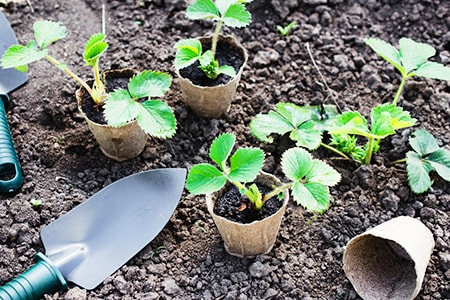
When you plant your strawberry plants, you need to leave a lot of space between the rows and among each plant. This is essential because strawberry seedlings love spreading around as they mature.
They love to sprawl, and it takes no time for the seedling to produce runners and daughter plants. Daughter plants would then further result in their runners, but bigger harvests later.
Leave about 20 inches between each plant on the row and 4 feet between the rows. Trim away any roots that grow more than 8 inches in length, if you can see them during transplanting. If you grow your strawberries from seeds then you won't be able to concern yourself with this. No big deal.
When planting strawberries in your garden, the holes you dig must be deep and wide enough to spread the roots around. However, if you dig too deep, then the buds will also settle into the soil over time.
This should be avoided at all costs because if the bud goes in the soil, the chance to rot the buds and stems increases drastically. The buds should be just above the surface. The crown, flower, and leaves must all be out in the fresh air.
The crown is the main growing bud you see above the root system. Do not bury the crown! Remember that the soil will settle some since we aren't packing it down tightly.
Once you're done planting all of your seedlings (we do recommend transplanting established plants since they resist inclement weather, pests, and disease better) go ahead and give them all their first solid watering.
Caring for Strawberry Plants
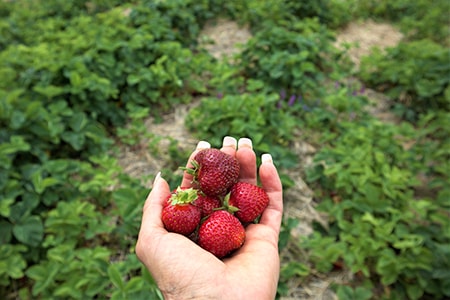
Strawberry plants need to stay hydrated, and they require moisture. Regularly watering the plants is essential. You should provide them with at least one inch of water per week. Strawberry plant roots stay pretty shallow in the soil so you can't skip out on this chore.
This is especially important later when their flowers and runners are growing, and in the fall season once the plant is fully mature. In these time periods the water demand is highest and needed to thrive, spread out, and produce juicy strawberries.
The use of mulch is essential, too. You can apply any kind of mulch like straw, black plastic (which I don't like visually), etc. The main point here is to ensure that the soil retains some moisture while still draining otherwise.
Weeds are an enemy to all plants because they compete for the nutrients in the soil, so keep your garden clean from weeds. Clear them out regularly. Every day when you walk out and observe your garden, just pick out any weeds you see trying to grow. It only takes a minute or two.
Use fertilizers that include all-purpose granules. This will ripen your strawberries only in 30 days of warm temperatures after you fertilize again when blossoming. Do this before you plant as discussed above and you then also add an inch of fertilizer when you see the flowering begin.
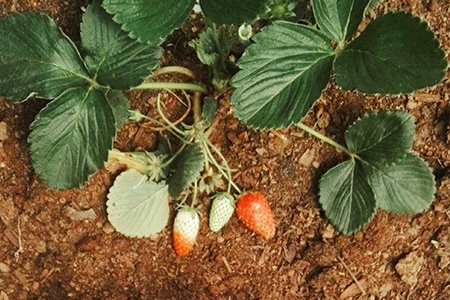
During the first year, if you're patient and can wait, it's best not to let them fruit. You can make this happen by picking out any flower blossoms that grow. This keeps the plants from expending energy on growing fruit and instead helps them establish stronger and larger root systems.
Again, doing this helps ensure healthy root growth, which leads to having as much as double the produce in the following year. If you plant two sets the first year, you can harvest one and let the others grow until the second year. Then begin planting a new batch each year and you'll always have access to fresh harvests.
Also, they're far more likely to grow daughter plants which produce much higher yields of crop. If you choose to do this, try to keep the daughters about 10 inches apart if possible.
Strawberries can tolerate cold weather well, but when the temperature goes below 20 degrees Fahrenheit, they go into their dormant state. At this point, taking extra care of the plant is extremely important.
Once the temperature in your region reaches that, cut the foliage of your plant down to an inch in length. Also keep a layer of 4 inches of mulch around your plant to keep them insulated and warm. You don't need to water during this time. You can let the rain and snow handle it.
Once you roll back around to spring again, you can remove this excess mulch, which is a critical part of how to grow strawberries. But make sure you only do this after the first frost has come and gone. Otherwise they'll try to acclimate and then get a shock to their system once it freezes again.
How to Harvest Strawberries
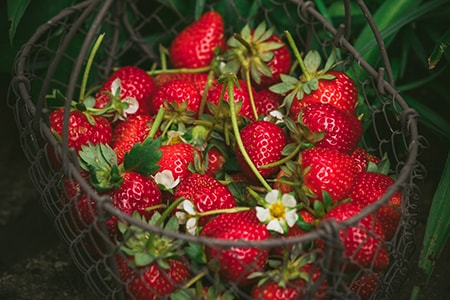
You can harvest strawberries after 4 to 6 weeks after they blossom. You only want to take the fully ripe fruits, which will have their brightest red coloring at that point in time. Try to leave three days between each harvest so the plants can recover from the shock.
Cut your strawberry from their stem, and avoid pulling as it may cause damage to the plant. By cutting you do the most minimal damage to the plant, which they can easily overcome. Typically the harvests will last 2 to 3 weeks, so don't feel anxious about picking any strawberries before they're ready.
How to Store Strawberries
To store strawberries, you can either refrigerate them for about 3-4 days before they go soft or you can freeze them for two months before you need to use them. Don't wash them before storing them, but do before you use them in a meal. Strawberries are the best when eaten fresh, of course, so do that if you can.
Diseases Commonly Found in Strawberries
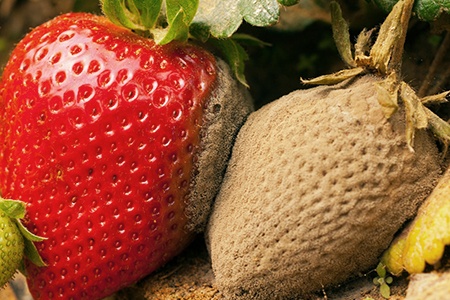
There are a few diseases or pests commonly found in strawberry plants, which can include slugs, powdery mildew, Japanese beetles, gray mold, and spider mites.
To keep your strawberry plant safe from slugs and bugs, keep the garden free of weeds, which attract insects. You can use sand over the plant's bed and mulch as well as a deterrent and camoflauge.
If the problem is the Japanese beetle, which is bigger, you can use organic insecticide like garlic oil spray or neem oil spray. Neem oil spray works for spider mites to, so you won't be stuck wondering where spider mites come from, since they appear out of nowhere, seemingly.
To scare away any birds preying on your yummy strawberries, make a scary face on a balloon and put them in a position above the strawberry plant's bed where birds can see it. Or you can invest in or make a real scarecrow, which is always fun to decorate.
That's How to Grow Strawberries!
Strawberries aren't delicate and don't require a lot of effort. If it's your first time growing any fruit, berries are the best to begin. All the beginners can take advantage of our guide and grow their fresh strawberry produce efficiently.
You won't be able to go back to the store brought strawberries after you have a taste your home-grown ones. They're going to be way sweeter and organic than the once found on the shelf in the store because, like every other fruit the sugars starts to convert into starch once you pick it off the plant. And now you know how to grow strawberries like a professional farmer.



